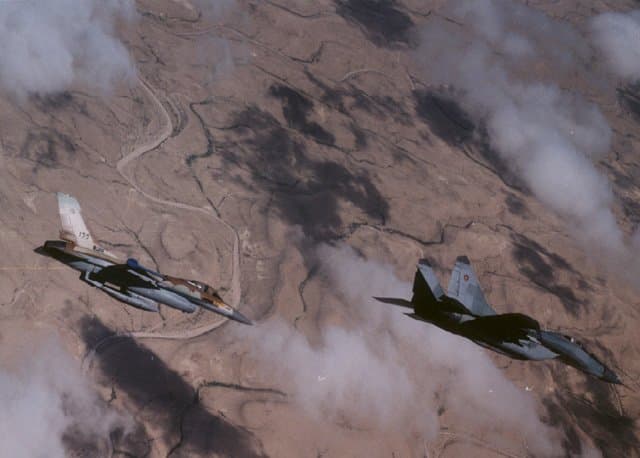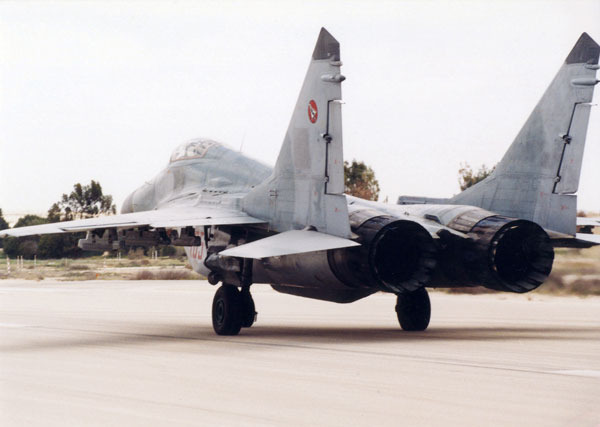- Yes
- No
Suggestion No.62
G’day lads. I want to suggest an Israeli tested Polish MiG-29, specifically the 9.12 variant, where it was also painted in the IAF 253 Squadron emblem :)

Description:
Spoiler
The MiG-29A 9.12, also known as the MiG-29 “Fulcrum-A,” is a twin-engine air superiority fighter aircraft developed by the Mikoyan design bureau in the Soviet Union. It was designed to counter U.S. fighters such as the F-15 Eagle and the F-16 Fighting Falcon. The MiG-29A 9.12 is known for its agility, high-performance capabilities, and advanced avionics systems. This agility is achieved with it’s RD-33 engines, paired with it’s light weight. It is equipped with a Phazotron N019 radar, helmet-mounted sight, and an IRST system, allowing for effective target acquisition and engagement. The aircraft is armed with a 30mm GSh-30-1 cannon and can carry a variety of air-to-air missiles, including R-27, R-60 and R-73’s. This one was leased and evaluated/tested by Israel, where they said that it’s a worthy opponent if flown by a professional.

History:
Spoiler
In 1997, the Israeli Air Force acquired three MiG-29 “Fulcrum” fighter jets from a secretive source, which was later found out to be Poland. These jets were brought to Israel under a veil of secrecy, allowing Israeli test pilots to thoroughly study and understand the aircraft and its weapon systems. For many weeks, the Israeli pilots engaged in extensive testing, flying numerous hours and evaluating the MiG-29’s capabilities against Israeli fighter jets. The 253 Squadron were the ones who tested the Fulcrum, with their emblem also being painted on all 3 of the aircraft.


Major N, the Chief Experimental Pilot of the MiG, noted that the MiG-29’s performance was comparable to, and in some respects surpassed, that of the F-15 and F-16 jets. The presence of these MiG-29s provided the IAF with a rare opportunity to closely examine one of the primary jets used by it’s enemies.
The Israeli pilots had to undergo special training to familiarize themselves with the MiG-29’s unique structure and systems. The language barrier was a significant challenge, as the aircraft’s documentation and voice warning systems were in Russian, requiring the use of translators and improvisation.
Despite these challenges, the pilots quickly adapted to the MiG-29, labeling cockpit instruments with English translations. They observed notable differences between the Eastern and Western approaches to jet construction. The MiG-29 featured advanced systems such as an automatic landing system and stabilization aids for pilots experiencing vertigo, which are systems not found in Western aircraft.

The IAF pilots conducted daily test flights, rigorously analyzing the MiG-29’s performance and weapon systems. The aircraft’s maneuverability, high thrust-to-weight ratio, and advanced avionics made it a formidable opponent in air combat. Major N praised the MiG-29’s radar and infrared search-and-track systems, which provided significant advantages in air-to-air combat.

However, the MiG-29’s human engineering had its drawbacks. Major N pointed out that while the individual systems were generally good, their combination and user interface were cumbersome and needed improvement.
Lieut. Col. G, who flew both the MiG-29 and the American F-18, noted the resemblance between the two jets. However, the MiG-29 was primarily designed for air combat, while the F-18 also served as an attack aircraft.
Bonus history (from the book listed in sources):
Spoiler
The trials took place at Sedom airbase in the Negev Desert, southern Israel. The two units conducting the trials were No.601 Squadron (the IDF/AF Flight Test Centre) and No.253 Squadron “Negev,” which operated the F-16A/B Fighting Falcon (called Netz by the Israelis). No.601 Squadron examined the MiG-29’s systems and explored its flight envelope, while No.253 Squadron was responsible for dissimilar air combat training (DACT) evaluation.
The MiG-29s retained their standard two-tone grey camouflage with the Polish ‘chequerboard’ insignia, and the unit badge of the 1st Fighter Regiment (1.PLM) was painted over in a lighter shade of grey (see the first image in the history section). The red/white badge of No.253 Squadron was carried on the fins, but the IDF/AF roundels were not applied. The preparatory stage of the tests posed several challenges, including translating all technical manuals into Hebrew and providing Hebrew-worded labels for the cockpit’s warning lights and critical switches. The audio warning system’s messages remained in Russian.
After lead-in training, each Israeli pilot involved in the evaluation flew 20 DACT sorties in the MiG-29 against the McDonnell Douglas F-4E (locally known as the Kurnass), the F-15A/B (locally known as the Baz), and the F-16A/B. The Israeli pilots rated the MiG-29 as excellent and a dangerous opponent in dogfights. They found the Shchel’-1UM helmet-mounted sight to be comparable to the systems developed in Israel for the F-16C Barak and F-15.
An Israeli military spokesman stated that the IDF/AF did not plan to purchase the MiG-29. Instead, the evaluation aimed to explore upgrade possibilities for Israel Aircraft Industries (IAI) and develop anti-Fulcrum tactics. Elbit Electronics, a division of IAI, had previous experience with Soviet/CIS aircraft, having successfully upgraded the MiG-21MF Fishbed-J for Romania (known as the LanceR) and the Antonov An-72P Coaler-C border patrol aircraft. The evaluation aimed to improve Israeli pilots’ ability to counter the MiG-29 in potential conflicts. As a result, the IDF/AF developed new models of helmet-mounted sights, combined with Rafael Python 4 and AIM-120 AMRAAM missiles, to give Israeli pilots an advantage in dogfights against Russian fighters.
Israeli experts believed that the MiG-29 was at least as good as, and in some respects better than, the F-15 and F-16 in terms of aerodynamics and performance. They were impressed by its rugged design and low maintenance requirements. However, they noted that the MiG-29’s avionics suite was less capable than that of Western fighters. IAI discussed potential upgrade programs with several MiG-29 operators, including Poland, Romania, Slovakia, and Ukraine.
Armaments:
Spoiler
1 GSh-30-1 30mm cannon with 150 rounds
6 R-73 AAM
6 R-60 AAM
2 R-27 AAM
(R-73’s, aswell as it’s 6 pylons are shown)
N019(E) radar
OEPS-29(E) IRST



Specifications:
Spoiler
The MiG-29 has a length of 17.32m, a height of 4.73m and a wingspan of 11.36m, where it gets a wing area of 38 square meters. It weights around 11000kg empty, a gross weight of 14900kg and a MTOW of 18000kg (although I think that the 9.12 is a little lighter). It is powered by 2 RD-33 afterburing turbofan engines, giving out 49.4kN dry and 81.6kN wet aka with afterburner.

Sources:
Spoiler
Mikoyan MiG-29 (Famous Russian Aircraft) 2007 (1857802314)
Israel’s Secretive MiG-29 Fulcrum Test Program
Israeli Fulcrums! The saga of IAF’s MiG-29 fighter jets - The Aviation Geek Club
Thanks a lot for reading! If you have any extra information, then feel free to share them in the replies! As always, have a good day :)